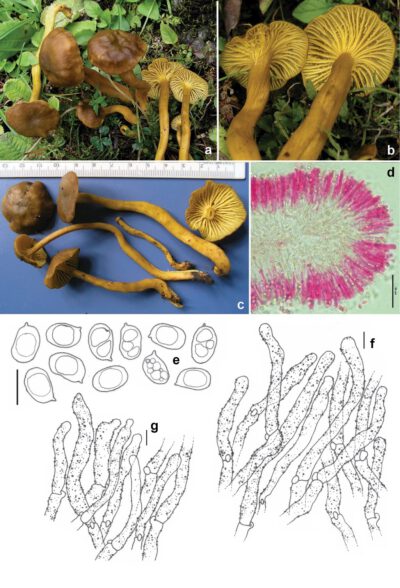Fungalpedia – Note 195, Cantharellus
Cantharellus Adans. ex Fr.
Citation if using this entry: Bera et al. 2024 (in prep) – Fungalpedia, Basidiomycota 1.
Index Fungorum, MycoBank, Facesoffungi, GenBank, Fig. 1
Classification: Cantharellaceae, Cantharellales, Agaricomycetes, Basidiomycota, Fungi
Cantharellus, frequently referred to as “chanterelles” is one of the highly regarded edible mushrooms since medieval times for its culinary-medicinal activity (Danell 1994, 1999, Muszyńska et al. 2016). However, the taxonomic classification of this genus has been a subject of controversy for an extended period. The generic concept of Cantharellus has significantly evolved over the years (Buyck et al. 2014). For a considerable time, “Cantharellus” was used as an umbrella name for all the taxa having characteristic veins or “false gills” instead of distinct gills in hymenium. Evidently, Cantharellus has frequently been mistaken for Craterellus Pers. With the progress in micro-morphological characterization, the identifying characters of the Cantharellus were well established at the beginning of the 20th century (Buyck et al. 2014). Based on this, Craterellus was eventually considered a separate genus or included as either a subgenus or section under Cantharellus (Buyck et al. 2014). According to the Friesian classification system, both Cantharellus and Craterellus were categorized within the “Aphyllophorales” group prior to the phylogenetic studies (Buyck et al. 2014, 2016). With the advent of molecular studies, Craterellus was strictly delimited from Cantherellus based on their difference in the nrITS sequence length (Feibelman et al. 1994, Buyck et al. 2014). However, progress in the study of Cantharellus has been slow due to the lack of diversity in distinguishing characteristics (Buyck et al. 2014). Lacking adequate microscopic variations, the overall field characteristics played a significant role in species descriptions and general identifications. This reliance led to numerous superfluous taxa in Europe (Buyck et al. 2014, Olariaga et al. 2015, 2016).
Currently, with the advancement in taxonomic studies, most previously ascribed taxa for Cantharellus species are now shifted to at least 40 different genera and nine distinct orders within the Hymenomycetes group (Buyck et al. 2014, 2016). As per the classical descriptions by Smith & Morse (1947), Petersen (1969, 1971), Danell (1994), Feibelman et al. (1997), and Pegler et al. (1997), Cantharellus has fleshy, gymonocarpic basidiomata with a sterile surfaced pileus (Danell 1999). The hymenium is smooth or folded extending to ridges on the pileus and stipe (Danell 1999). In contrastto the monolayered basidia in Agaricales, Cantharellus is characterized by basidia developing on the layer of older ones which makes the thickened hymenium on maturity (Danell 1999). The basidia in this genus are stichic, with long, curved sterigmata (Juel 1916, Danell 1999) bearing smooth basidiospores (Danell 1999). Proven by the nuclear migration theory by Maire (1902), the spore number can vary from two to eight per basidium per basidiomata (Danell 1999). There is no evidence of cystidia in Cantharellus. The hyphal system is monomitic with the presence of clamp connections (Danell 1999).
A comprehensive morphological examination of the available type materials for Cantharellus species worldwide led to the initially structured categorization into six subgenera based on morphological characteristics (Eyssartier & Buyck 2001a, b, Buyck et al. 2014). The two proposed microcharacteristics for subgeneric divisions are the presence or absence of clamp connections, and the presence or absence of thick-walled pileus hyphal terminations (Buyck et al. 2014). This subdivision marked a significant advancement in understanding Cantharellus species (Buyck et al. 2014). Buyck et al. (2014) presented the first multigene phylogenetic approach (nucLSU, mitSSU, rpb2, and tef-1) for infrageneric classification of this genus comprising most of the described chanterelles worldwide. Currently, this ectomycorrhizal mushroom in which occurs association with pine, spruce, oak and hornbeam trees contains approximately 200 species globally (Species Fungorum 2023).
Synonyms: Cantharellus Lam., Chanterel Adans., Goossensia Heinem., Hyponevris Paulet, Merulius Haller ex Boehm., Merulius Haller
Type species: Cantharellus cibarius Fr.
Other accepted species: (Species Fungorum – search Cantharellus)
Figure 1 – Cantharellus sikkimensis (Holotype KD 13-024). a Basidiomata. b Hymenophore showing strongly interveined gill-folds. c Immature to mature basidiomata on the workout table. d Hymenium layer towards the edge of gill-fold. e Basidiospores. f & g Ascending to subparallel terminal and subterminal encrusted cells of the hyphae in pileipellis. Scale bars: d = 50 μm, e–g = 10 μm. Taken from Das et al. (2015).
References
Entry by
Ishika Bera, Center of Excellence in Fungal Research, Mae Fah Luang University, Chiang Rai 57100, Thailand
(Edited by Kevin D Hyde, Samaneh Chaharmiri-Dokhaharani, & Achala R. Rathnayaka)
Published online 6 February 2024
